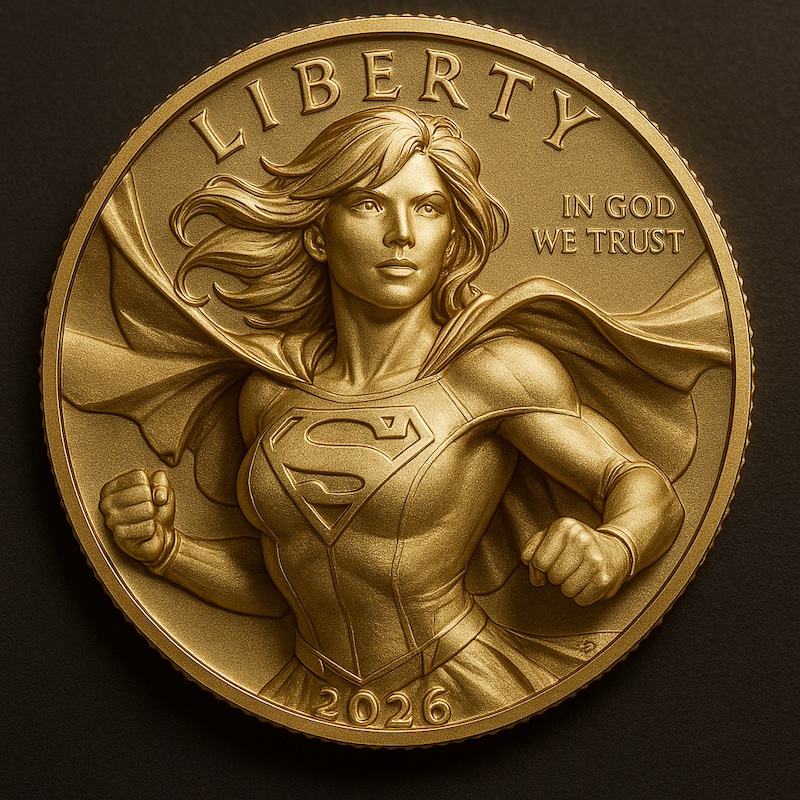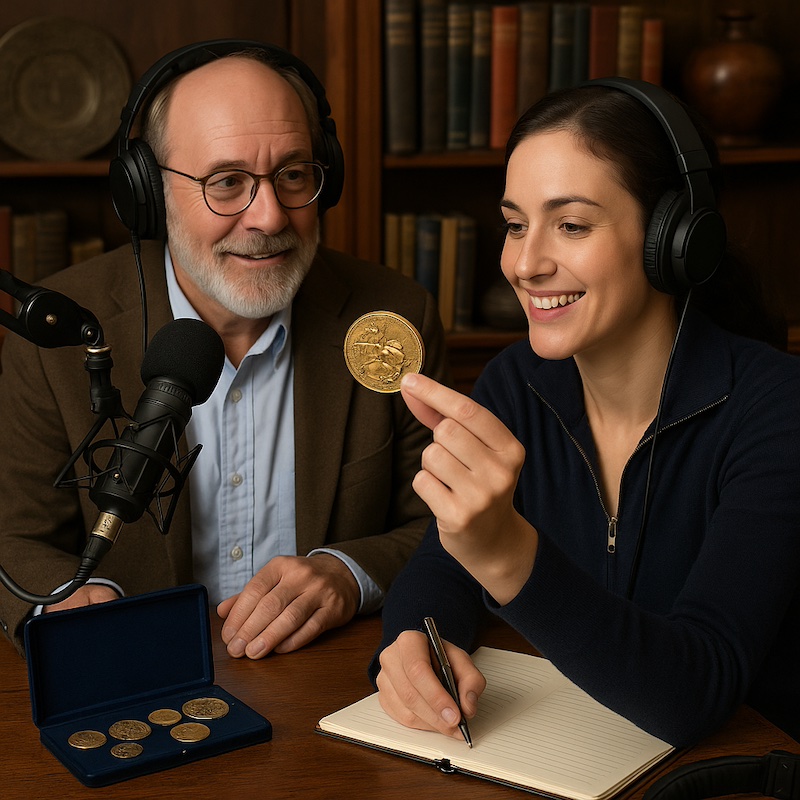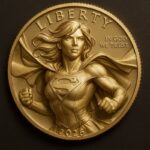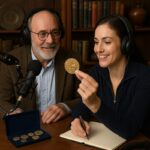Three legendary U.S. gold pattern coins — including an 1880 Coiled Hair Stella — each sold for over $2 million at Heritage Auctions’ August 2025 ANA Signature Sale. The total U.S. coin session brought in more than $51 million, reflecting sustained strength in the numismatic market despite economic uncertainty. Experts say collector demand for ultra-rare gold patterns continues to surge, reaffirming their place as “blue-chip” assets in the world of tangible investments.
A Record-Setting Moment for Rare U.S. Gold Coins
When the hammer fell at Heritage Auctions’ ANA U.S. Coins Signature Auction this August, numismatists worldwide took notice.
The star of the event — a Proof 67 1880 Coiled Hair Stella gold $4 pattern coin — realized a staggering $2.28 million, leading a trio of historic coins that each broke the $2 million barrier.
The sale wasn’t just another high-profile auction; it underscored the ongoing strength of the rare coin market amid shifting global financial conditions. With total auction proceeds surpassing $68 million, the event proved that exceptional U.S. rarities continue to attract deep-pocketed collectors and investors alike.
“The results speak volumes about the market’s confidence in tangible assets and the growing global respect for U.S. numismatic artistry,” said Todd Imhof, Executive Vice President of Heritage Auctions.
The 1880 Coiled Hair Stella: A Masterpiece of U.S. Coinage
Among American numismatic treasures, few rival the mystique of the 1880 Coiled Hair Stella gold $4 coin.
Cataloged as Judd-1660, this coin represents one of only nine known examples — a pattern piece conceived during an experimental phase in U.S. coinage history.
Struck in Proof 67 condition and authenticated by NGC with CAC approval, the coin’s rarity, preservation, and historical importance drove intense bidding. It ultimately achieved $2.28 million, the second-highest price ever realized for its type.
Why the Stella Matters
- The Stella was designed during the late 1870s to facilitate international trade, denominated in a “four-dollar” value intended to align with European currency standards.
- Two major obverse designs exist: Flowing Hair and Coiled Hair, both based on George T. Morgan’s and Charles E. Barber’s artistic direction.
- The Coiled Hair version is significantly rarer, commanding multi-million-dollar prices when it appears on the market.
Other Multi-Million-Dollar Highlights
Heritage’s sale didn’t end with the Stella. Two additional rarities joined the exclusive “$2 Million Club”:
1. 1879 Quintuple Stella Gold $20 Pattern (Proof 64 Deep Cameo)
- Realized Price: $2,160,000
- Cataloged As: Judd-1643 / Pollock-1843
- Rarity: Only five known examples
- Previously sold for $1.88 million in 2016, this coin’s 2025 performance marked a new record.
- One specimen resides in the Smithsonian Institution, underscoring the historical and cultural value of this design.
2. 1874 Bickford $10 Pattern (Proof 65 Deep Cameo)
- Realized Price: $2,040,000
- Cataloged As: Judd-1373 / Pollock-1518
- Rarity: Just two examples known
- This specimen surpassed its 2022 record of $1.98 million, continuing a steady upward trend in value for ultra-scarce patterns.
The Costa Family Collection: A Legacy of Excellence
All three of the record-breaking coins came from The Costa Family Collection, Part I, a consignment of 94 lots that drew remarkable enthusiasm.
Highlights included:
- 1879 Coiled Hair Stella ($4) – PCGS Proof 65, CAC-approved, sold for $1.44 million, surpassing its 2019 record.
- 1852 Augustus Humbert $50 Gold Slug – PCGS MS64, realized $690,000, far exceeding its 2014 record of $411,250.
- 1880 Flowing Hair Stella – NGC Proof 66 Cameo, achieved $492,000.
“The Costa Collection represents decades of refined taste and scholarship,” noted a Heritage catalog specialist. “Every coin tells a story of American ingenuity and the collector’s unwavering commitment to quality.”
Why This Auction Matters Now
The numismatic market in 2025 continues to defy expectations. While broader economic sectors experience volatility, rare coins have demonstrated resilience and growth, especially at the top end of the market.
Key Market Insights
- Total Heritage Auction Proceeds: $68,126,706
- U.S. Coins Portion: $51,171,731
- Top Coin Prices: Three exceeded $2 million, several more surpassed six figures.
- Market Sentiment: Bullish for elite rarities, steady for mid-tier collectibles.
Industry analysts attribute this performance to several factors:
- Increased global participation – Wealthy collectors from Asia and Europe are increasingly active in U.S. coin auctions.
- Inflation hedging – Investors seek tangible assets like gold coins as stable stores of value.
- Generational transfer – Major private collections are entering the market as estates change hands, fueling supply and demand.
Expert Analysis: What It Means for Collectors and Investors
The stellar results from Heritage Auctions signal important takeaways for today’s collectors and investors:
1. Rarity and Provenance Reign Supreme
Coins with impeccable provenance — like those from the Costa Family Collection — command premiums. Documentation, grading, and certification from NGC, PCGS, and CAC play an essential role in establishing market confidence.
2. Pattern Coins Continue to Outperform
Pattern coins (experimental strikes or design trials) have consistently outpaced standard issues in value appreciation. Their small populations and unique historical context attract both collectors and institutional investors.
3. The Market Rewards Quality
Condition remains a decisive factor. Coins in Proof 65 or better grades can see exponential value growth compared to lower-graded examples, even within the same rarity class.
4. Auctions Remain a Transparency Benchmark
Major auction houses like Heritage, Stack’s Bowers, and GreatCollections provide the transparency, provenance validation, and global exposure that high-value coins require.
The Broader Investment Picture
Numismatics continues to evolve as both a passionate pursuit and a legitimate investment class.
According to Heritage’s Todd Imhof, “Despite cyclical skepticism, the collector base continues to expand. Each record-breaking sale reminds us that coins aren’t just historical artifacts — they’re financial instruments of enduring beauty.”
Comparing Coins to Other Tangible Assets
| Asset Type | Liquidity | Historical ROI | Volatility | Market Transparency |
|---|---|---|---|---|
| Rare Coins | Medium | 8–12% annually (long-term avg.) | Low to Moderate | High (auctions, grading) |
| Gold Bullion | High | 6–8% | Moderate | High |
| Fine Art | Low | Variable | High | Moderate |
| Vintage Cars | Low | 7–10% | High | Low |
Rare coins occupy a unique niche — combining aesthetic, historical, and intrinsic gold value. As such, they serve as both collectibles and portfolio diversifiers.
Potential Risks and Considerations
While opportunities abound, collectors should remain aware of potential risks:
- Market Saturation: Common or modern commemoratives may stagnate in value.
- Authentication Risks: Always buy from reputable sources or auction houses.
- Liquidity Challenges: Selling high-value coins takes time; auction scheduling and fees can affect timing.
- Market Cycles: The coin market, like any investment, moves in cycles tied to economic confidence and discretionary spending.
Conclusion: A Bright Future for American Numismatics
The record-breaking Heritage auction reaffirms the enduring vitality of the U.S. rare coin market.
As ultra-rare gold patterns like the 1880 Coiled Hair Stella achieve new milestones, they remind collectors why numismatics remains a powerful blend of history, artistry, and investment potential.
Whether you’re a seasoned numismatist or a new collector, the lesson is clear:
Quality, rarity, and provenance continue to define success in this thriving, sophisticated market.
Call-to-Action:
Stay informed with trusted sources like Coin World and Heritage Auctions. Explore upcoming auction catalogs, study past results, and consider expert appraisal services before making your next acquisition.
FAQ: Rare Coin Market Insights
1. Why is the 1880 Coiled Hair Stella so valuable?
Because only nine examples exist, it’s among the rarest U.S. pattern coins. Its condition, historical importance, and artistry make it highly desirable.
2. How do coin patterns differ from circulation coins?
Pattern coins were prototypes or experimental designs never issued for circulation, often struck in limited numbers.
3. Is now a good time to invest in rare coins?
With inflation and market volatility, tangible assets like rare coins have become attractive for diversification and long-term preservation.
4. How can I verify a coin’s authenticity?
Buy coins graded by PCGS or NGC, ideally with CAC approval, and review auction provenance.
5. What’s the best way to start collecting?
Begin with reputable dealers, coin shows, or online platforms. Study auction archives to understand grading, rarity, and pricing trends.







